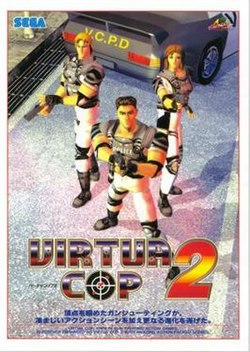Arcade
In Japan, Game Machine listed Virtua Cop 2 on their November 1, 1995 issue as being the second most-successful dedicated arcade game of the month. [22] It went on to become the highest-grossing dedicated arcade video game of 1996 in Japan. It was reported to have sold 7,000 arcade cabinets worldwide by 1996, including 4,000 units in Japan and 3,000 units overseas. [1]
Reviewing the arcade version, a Next Generation critic commented that "the action, enemies, variation of levels and backgrounds, and the fun are all so improved over Virtua Cop 1, and in all the right places, that no other laser-gun shooter comes close to it right now." He especially praised the high frame rate, the level design, the need for skilled aiming, and the way the game is paced such that bouts of intense shootouts with "multitudes of terrorists" are broken by short pauses to give the player a breather. [19]
Saturn
As with the original Virtua Cop, the Saturn version of Virtua Cop 2 received mostly positive reviews for its fun gameplay [17] [18] [20] [21] [23] and close translation of the arcade version, [17] [18] [20] [21] [23] while being criticized as too lacking in longevity for a home console game. [17] [23] However, some critics, rather than complaining about the longevity, noted that while it takes about the same amount of time to complete a single playthrough as in the original, the game is much longer than the first Virtua Cop when taking into account all the different level branches. [18] [21]
Reviews generally hailed the game as a considerable improvement over the already impressive original, due to its more interactive environments [20] [21] and higher intensity, especially in the chase scenes. [17] [18] [20] [21] [23] Next Generation elaborated, "Taking the game one step closer to the feel of a big budget action movie, Virtua Cop 2 seems to have more 'movement' to it. ... Whether chasing down an armored car while picking off bad guys hanging out the window, or dodging bullets in a speeding subway train, this game is just short of being described as a roller coaster ride by some hack movie critic in the Midwest and even closer to being described as an 'edge of your seat thriller' by this reviewer on the West coast." [20] GamePro had a somewhat more tempered response, arguing that one can still quickly memorize the game, making repeat plays increasingly routine. They concluded, "For lightgun fans, VC2's a solid buy. Otherwise, its short-lived but frenzied fun makes for a top Saturn rental." [23]
The four reviewers of Electronic Gaming Monthly had similar reactions, [17] while Rich Leadbetter of Sega Saturn Magazine argued that even the shorter Virtua Cop has far more longevity than it is usually given credit for, as both it and the sequel have numerous modes and approaches that can provide players with new challenges on repeat plays. [21] Tom Ham wrote in GameSpot , "While the first Virtua Cop set a new standard for light gun shooters, Sega and the AM2 team have delivered an incredible sequel that takes the concept to a whole new level." [18]
Electronic Gaming Monthly named the Saturn version a runner-up for Shooter Game of the Year (behind Alien Trilogy ). [24] In 1997, they named the Saturn version number 98 on their "100 Best Games of All Time", citing its addition of branching levels and innovative stage design to the series' revolutionary use of polygonal enemies which move realistically and react differently depending on where they are shot. [25]
